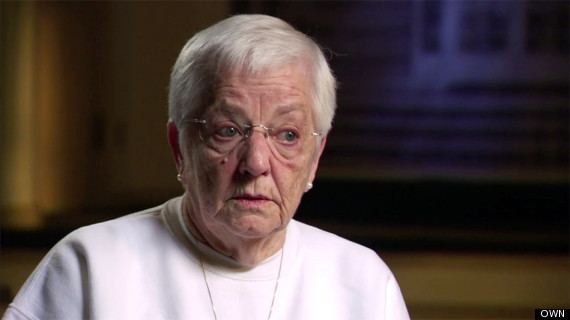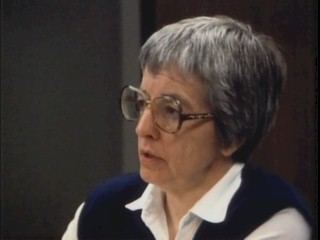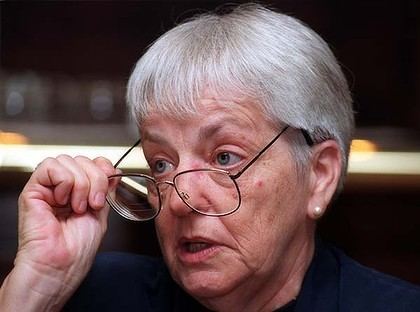Nationality American Ethnicity White American | Name Jane Elliott Role Schoolteacher | |
 | ||
Known for "Blue eyes–Brown eyes" exercise Books Mummy's Little Girl: A Desperat, Mummy’s Little Girl: A Heart‑ren, Sadie, Alice all'inferno, Energise: Scouting Similar People Bertram Verhaag, Jane Elliot, Claus Strigel | ||
The event how racist are you with jane elliott channel 4 full
Jane Elliott (née Jennison; born May 27, 1933) is an American former third-grade schoolteacher, anti-racism activist, and educator, as well as a feminist and an LGBT activist. She is known for her "Blue eyes–Brown eyes" exercise. She first conducted her famous exercise for her class the day after Martin Luther King, Jr. was assassinated. When her local newspaper published compositions that the children had written about the experience, the reactions (both positive and negative) formed the basis for her career as a public speaker against discrimination. Elliott's classroom exercise was filmed the third time she held it with her 1970 third-graders to become The Eye of the Storm. This in turn inspired a retrospective that reunited the 1970 class members with their teacher fifteen years later in A Class Divided. After leaving her school, Elliott became a diversity educator full-time. She still holds the exercise and gives lectures about its effects all over the U.S. and in several locations overseas.
Contents
- The event how racist are you with jane elliott channel 4 full
- Epigenetics of racism with jane elliott
- Early life and career
- Motivation to teach about racisms effects
- First exercise involving eye color and brown collars
- Reactions and public attention
- Origin of workplace diversity training
- Legacy of the original exercise
- Academic research into the Blue Eyes Brown Eyes exercise
- Personal life
- References

Epigenetics of racism with jane elliott
Early life and career

Elliott was born in 1933 to Lloyd and Margaret (Benson) Jennison on her family's farm in or near Riceville, Iowa. Her father, who delivered her, was Irish-American. She was the fourth of several children.

In 1952, after graduating from high school, Elliott attended the Iowa State Teachers College (now the University of Northern Iowa), where she attained an emergency elementary teaching certificate in five quarters. In 1953, she began her teaching career in a one-room school in Randall.
Motivation to teach about racism's effects

On the evening of April 4, 1968, Elliott turned on her television and learned of Dr. Martin Luther King Jr.'s assassination. She says that she vividly remembers a scene in which a white reporter pointed his microphone toward a local black leader and asked, "When our leader [John F. Kennedy] was killed several years ago, his widow held us together. Who's going to control your people?" Shocked that a reporter could feel that Kennedy was a "white people's leader", she then decided to combine a lesson that she had planned about Native Americans with a lesson that she had planned about Dr. Martin Luther King Jr. for February's Hero of the Month project. At the moment she was watching the news of King's death, she was ironing a teepee for use in a lesson unit about Native Americans. To tie the two lessons together, she used the Sioux prayer "Oh great spirit, keep me from ever judging a man until I have walked in his moccasins.(sic)" She wanted to give her small-town, all-white students the experience of walking in a "colored child's moccasins for a day."
The following day, she held a class discussion about the lesson and also talked about racism in general. She later said: "I could see that they weren't internalizing a thing. They were doing what white people do. When white people sit down to discuss racism what they are experiencing is shared ignorance." Most of Elliott's eight-year-old students were, like her, born and raised in the small town of Riceville, Iowa and they were not normally exposed to black people. She felt that simply talking about racism would not allow her all-white class to fully comprehend racism's meaning and effects.
First exercise involving eye color and brown collars
Steven Armstrong was the first child to arrive in Elliott's classroom, (referring to Martin Luther King, Jr.) he asked "Why'd they shoot that King?" After the rest of the class arrived, Elliott asked them how they think it feels to be a black boy or girl. She suggested to the class that it would be hard for them to understand discrimination without experiencing it themselves and then asked the children if they would like to find out. The children agreed with a chorus of "yeah"s. She decided to base the exercise on eye color rather than skin color in order to show the children what racial segregation would be like.
On the first day of the exercise, she designated the blue-eyed children as the superior group. Elliott provided brown fabric collars and asked the blue-eyed students to wrap them around the necks of their brown-eyed peers as a method to easily identify the minority group. She gave the blue-eyed children extra privileges, such as second helpings at lunch, access to the new jungle gym, and five extra minutes at recess. The blue-eyed children sat in the front of the classroom, and the brown-eyed children were sent to sit in the back rows. The blue-eyed children were encouraged to play only with other blue-eyed children and to ignore those with brown eyes. Elliott would not allow brown-eyed and blue-eyed children to drink from the same water fountain and often chastised the brown-eyed students when they did not follow the exercise's rules or made mistakes. She often exemplified the differences between the two groups by singling out students and would use negative aspects of brown-eyed children to emphasize a point.
At first, there was resistance among the students in the minority group to the idea that blue-eyed children were better than brown-eyed children. To counter this, Elliott lied to the children by stating that melanin was linked to their higher intelligence and learning ability. Shortly thereafter, this initial resistance fell away. Those who were deemed "superior" became arrogant, bossy, and otherwise unpleasant to their "inferior" classmates. Their grades on simple tests were better, and they completed mathematical and reading tasks that had seemed outside their ability before. The "inferior" classmates also transformed – into timid and subservient children who scored more poorly on tests, and even during recess isolated themselves, including those who had previously been dominant in the class. These children's academic performance suffered, even with tasks that had been simple before.
The next Monday, Elliott reversed the exercise, making the brown-eyed children superior. While the brown-eyed children did taunt the blue-eyed children in ways similar to what had occurred the previous day, Elliott reports it was much less intense. At 2:30 on that Wednesday, Elliott told the blue-eyed children to take off their collars. To reflect on the experience, she asked the children to write down what they had learned.
Reactions and public attention
The compositions that the children wrote about the experience were printed in the Riceville Recorder on page 4 on April 18, 1968, under the headline "How Discrimination Feels", and the story was picked up by the Associated Press. Because of the Associated Press article, Elliott was invited to appear on The Tonight Show Starring Johnny Carson. After she spoke about her exercise in a short interview segment, the audience reaction was instant as hundreds of calls came into the show's telephone switchboard, much of it negative. An often-quoted letter stated, "How dare you try this cruel experiment out on white children? Black children grow up accustomed to such behavior, but white children, there's no way they could possibly understand it. It's cruel to white children and will cause them great psychological damage."
The publicity that Elliott was getting did not make her popular in Riceville. When she walked into the teachers' lounge the day after her Tonight Show appearance, several other teachers walked out. When she went downtown to do errands, she heard whispers. When her oldest daughter went to the girls' bathroom in junior high, she came out of a stall to see a hateful message scrawled in red lipstick for her on the mirror.
Of all her coworkers, Elliott states that only one of them, Ruth Setka, continued to speak to her after her exercise went public. Setka said that she realized she was the only one who kept speaking to her. Setka believed that the reason Eliott's exercise got so much backlash was because the students were very young and that the exercise should have been done on at least junior high school aged students. In an 2003 interview, Elliot said that about 20% of the Riceville community were still furious with her over what she did on April 4, and some still call her "n-word lover", but she was grateful for the other 80%.
However, as news of her exercise spread, she appeared on more television shows and started to repeat the exercise in professional training days for adults. On December 15, 1970, Elliott staged the experience to adult educators at a White House Conference on Children and Youth.
In 1970, ABC produced a documentary about Elliott called The Eye of the Storm, which made her even more nationally known. Subsequently, William Peters wrote two books—A Class Divided and A Class Divided: Then and Now—about her and the exercise. A Class Divided was turned into a PBS Frontline documentary in 1985 and included a reunion of the schoolchildren featured in The Eye of the Storm, for which Elliott received The Hillman Prize. A televised edition of the exercise was shown in the United Kingdom on October 29, 2009, on Channel 4 entitled The Event: How Racist Are You? This documentary was intended, according to the producers in their agreement with Jane Elliott, to create an awareness of the effects of racist behaviors by using UK citizens. After the exercise, Elliott said that the result "wasn't as successful as I am accustomed to being."
Elliott was featured by Peter Jennings on ABC as "Person of the Week" on April 24, 1992. She is listed on the timeline of 30 notable educators by textbook editor McGraw-Hill along with Confucius, Plato, Booker T. Washington, and Maria Montessori. She has been invited to speak at 350 colleges and universities and has appeared on The Oprah Winfrey Show five times.
In November 2016, Elliott's name was added to the BBC's annual list of 100 Women.
Origin of workplace diversity training
Elliott is considered to be the forerunner of diversity training, with the Blue-Eyes-Brown-Eyes exercise as the basis of much of what is now called diversity training. She has done such training for corporations such as General Electric, Exxon, AT&T, and IBM, as well as lectured to the FBI, IRS, US Navy, US Department of Education, and US Postal Service.
The Riceville school system granted Elliott unpaid leave to conduct workshops and training that were based on her exercise to organizations outside of her school system. However, the increasing demands to be away from the classroom eventually caused problems with her public school teaching career. Elliott left teaching in the mid 1980s to devote herself full-time to diversity training, redeveloping her classroom exercise for the corporate world. This was promoted positively as a way to promote teamwork, profits, and a "winning together" atmosphere. For this corporate exercise, Elliott divides a multiracial group based on the color of their eyes and then subjects the blue-eyed individuals to a withering regime of humiliation and contempt. In only a few hours, Elliott's treatment makes the blue-eyed workers become distracted and despondent, stumbling over the simplest commands.
Companies found the idea of offering such training attractive, not only because in the 1970s and 1980s there were increasing numbers of people of color in their organizations, but also because of U.S. court rulings and federal policies to promote multiculturalism brought about by pressure from civil rights groups during the same two decades.
Many companies at that time came to see diversity training as a way to ward off negative legal action and publicity. Elliott said, "If you can't think of any other reason for getting rid of racism, think of it as a real money saver." Elliott-inspired diversity training has been used outside the United States as well. Diversity training was little-known in the United Kingdom at the beginning of the 1990s; however, when the Race Relations Amendment Act 2000 passed in the UK, it listed 100 diversity training firms in the Diversity Directory. According to a survey by the Chartered Institute of Personnel and Development, 70% of firms have diversity policies in which diversity training plays a major role. Many of these courses are designed to have a "lighter touch" than Elliott's approach, but those based solidly on Elliott's model are also promoted.
Legacy of the original exercise
Dean Weaver, who was superintendent of Riceville schools from 1972 to 1979, thought she was an outstanding teacher who did things differently and made other teachers envious of her success. Ex-principal Steve Harnack commented that she was excellent at teaching academics and suggested she would have had fewer problems with the community if she had involved parents. Elliott's former colleague Ruth Setka comments on Riceville's attitude on Elliott: "Everyone's tired of her. I'm tired of hearing about her and her experiment and how everyone here is a racist. That's not true. Let's just move on."
Academic research into the Blue-Eyes-Brown-Eyes exercise
Academic research into Elliott's exercise shows moderate results in reducing long-term prejudice but is inconclusive on the question of whether the possible psychological harm outweighs the potential benefits. Measured results of the diversity training for adults are moderate. The outcomes of a 1990 research study by the Utah State University were that virtually all the subjects reported that the experience was meaningful for them. However, the statistical evidence supporting the effectiveness of the activity for prejudice reduction was moderate; and virtually all the participants, as well as the simulation facilitator, reported stress from the simulation.
Another program evaluation in 2003, conducted by Tracie Stewart at the University of Georgia, showed that white students got significantly more positive attitudes toward Asian-American and Latino individuals, but only marginally more positive attitudes toward African-American individuals. In some courses, participants can feel frustrated about "their inability to change" and instead begin to feel anger against the very groups to which they are supposed to be more sensitive. It can also lead to anxiety because people become hyper-sensitive about being offensive or being offended. There are not very good measures of effects on long-term outcomes of these training initiatives.
As a result of the 1990 research, Murdoch University did not include the Blue-Eyes-Brown-Eyes exercise in their list of successful strategies to reduce racism.
Personal life
Elliott was married to Darald Elliott (1934–2013) from 1955 to his death, and has four children. They maintained residences in Osage, Iowa and Sun City, California.
